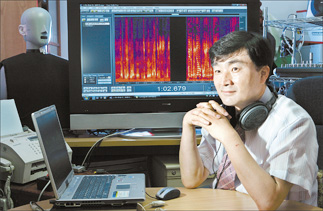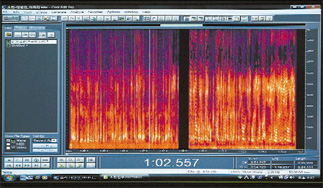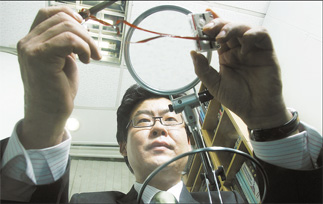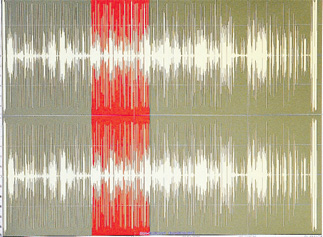Sound detectives find the truth in sounds that are often hidden

Sound has been a treasure trove of truth for Bae Myung-jin, who runs the Sound Engineering Research Center at Soongsil University. Using spectrograms and other tools, he turns sounds into visible data that can be analyzed. Bae recently discovered that the voice of the Taliban spokesman in the hostage crisis belonged to at least two different peopl
Bae, who heads the Sound Engineering Research Center at Soongsil University, finds that listening is sometimes a better way to find the truth.
His laboratory deals with criminal cases that require forensic acoustic investigation and he says the demand is high. However, kidnappings or extramarital affairs are not Bae’s only preoccupations.
He also devotes time to finding hidden truths in more exotic situations.
Last week he enjoyed extensive attention when he revealed that the voice found on recordings of purported Taliban spokesman Qari Yousuf Ahmadi belonged to at least two different people.
Bae uses a sound spectrogram for his analysis, although the device has its limits.

Bae came up with the finding that Ahmadi had a doppleganger after using his spectrogram to analyze nine recordings from July 21 to Aug. 2. He discovered that only six of them belonged to one person.
In the six recordings of the same voice, the spectrogram showed relatively few fluctuations and many repetitions of “uh” between words, meaning that the speaker had remained calm and thoughtful, Bae explained. Yet, the other recordings had a higher tone of voice and showed more active fluctuations, meaning that the speaker made many extra tongue movements. “The difference in resonance, frequency and spectrum proves that the speakers have different oral structures,” Bae said.

Kim Ho-sik examines a tape at the Korea Institute of Forensic Acoustics where he works. Kim mostly deals with criminal cases and often cooperates with the police.
Yuk was shot and killed on Aug. 15, 1974 during a ceremony to commemorate Korea’s liberation from Japanese colonial rule. It was widely believed that Yuk died after being hit by bullets fired by the assassin, Moon Se-gwang, an ethnic Korean who lived in Japan. However, Bae helped prove that it was a bullet from Yuk’s bodyguards that accidentally killed the first lady.
“After running the recording through the spectrogram, I extracted the hidden sound of a bullet being fired that matched the exact moment of Yuk’s collapse,” Bae said.
Other memorable findings include the audiotape that took the nation by storm just before the 2002 presidential election.
The tape was presented by Kim Dae-eop, a former military petty officer, who claimed it was a recording of conversations with Han In-ok, the wife of presidential candidate Lee Hoi-chang. The content of the tape suggested she was seeking ways for her two sons to dodge mandatory military service. Bae was asked to analyze the authenticity of the tape. He concluded it was a fabrication, with parts edited and altered. Kim was found guilty of falsehood and served a jail term, yet the ripples caused by the tape are remembered as a major reason Lee lost the election to Roh Moo-hyun.
Bae’s work is not limited to high-profile figures. There is also great demand for him in the field of forensic acoustics.
“From kidnapping to extramarital affairs, there are thousands of accusations each week, and I get requests for voice analysis for evidence,” Bae said.

“Voice is the key to the human heart,” he said. “As long as human beings are born with ears and a mouth, there will be constant demand for sound analysis for truth verification.”
To increase the quality of his analysis, Bae has been collecting voice samples from a thousand people of different ages, all taken under different conditions. This will provide him with a more extensive data-base for purposes of comparison.
Bae is also interested in other aspects of sound analysis. He has come up with a machine to provide a better study environment for students.
And he recently made a “friendly index machine” based on his belief that people in love come to have similar voice identities. This experiment got him in trouble when he found his friendly index with his wife was only 81 out of 100. “That made my wife angry,” he said.
Meanwhile, Kim Ho-sik, who runs the Korea Institute of Forensic Acoustics, remains focused on the dark side of voice analysis. Mostly dealing with criminal cases, Kim said that he works closely with the police on kidnappings, murders and extramarital affairs.
One of Kim’s most important cases was the 1991 kidnapping of nine-year-old Lee Hyeong-ho, who was found murdered after 44 days. The kidnapper evaded the police dragnet and the statute of limitations expired. The case grabbed nationwide attention and was made into a hit film called “Voice of a Murderer” last year.
“When the case occurred, forensic acoustics was not very advanced in Korea,” Kim said. “It’s a different story now, and I am analyzing the voiceprints of the criminal and other related voice data to find the truth behind this child’s tragic death.”
Kim, who also teaches at the Pochon Cha University Hospital, recently worked on a violent crime that left a 20-something woman in coma. She was attacked on her way home one night as she passed a building site in Yeoju city, Gyeonggi but police could not determine what had been used as the weapon. A recording of the assault was left on a cell phone belonging to a friend of the victim. Kim broke the recording up using a spectrogram to arrive at a picture of the minutes before the woman became unconscious.
After analyzing the frequency and resonance Kim decided that the culprit had used a brick from the construction site to hit the victim in the back of the head. “It was a complex job, digging into small sounds hidden in the recordings, trying to assemble the truth,” Kim said.
Kim’s contribution was a key factor in solving the 2005 kidnapping of a 60-year-old woman in Daejeon. Using recordings of phone calls made by the kidnapper, Kim detected the sound of a golf swing, a foreigner’s voice and a woman and a child calling a dog’s name. “Based on my findings, the police detected a golf course where there were lots of foreigners and families and they eventually found the victim,” Kim recalled. “Criminals don’t pay much attention to hiding sounds, although they work hard to conceal visual evidence.”
Kim gets many requests to investigate allegations of extramarital affairs, and these days it’s mostly men doubting the fidelity of their wives. “About three or four years ago, it was the other way around,” Kim said.
He said that his job has its downside. He has been attacked after giving evidence in court and he presumes the assailants were people who were damaged by his evidence. After years of working with sound, he makes sure that his house does not have any excess noise. “I don’t even have an analogue clock with ticking hands,” he said. “My home should be a place without a sound, so that I can get proper rest.”
Kim’s biggest concern is that there will not be enough experts in his field. “Korea has about 10 experts in forensic acoustics now, although the demand is on the increase,” he said.
Another forensic acoustics expert, Jeon Ok-yeub, an official at the acoustic phonetics department of the National Institute of Scientific Investigation, agrees.
Jeon has found key evidence as well, including people who made threats to bomb major buildings in central Seoul.
She explained that everyone has a voice identity that cannot be hidden or disguised, so it is no use for suspects to try to use different accents or dialects. “Voice is a relatively honest form of data,” she said.
By Chun Su jin [sujiney@joongang.co.kr]










with the Korea JoongAng Daily
To write comments, please log in to one of the accounts.
Standards Board Policy (0/250자)